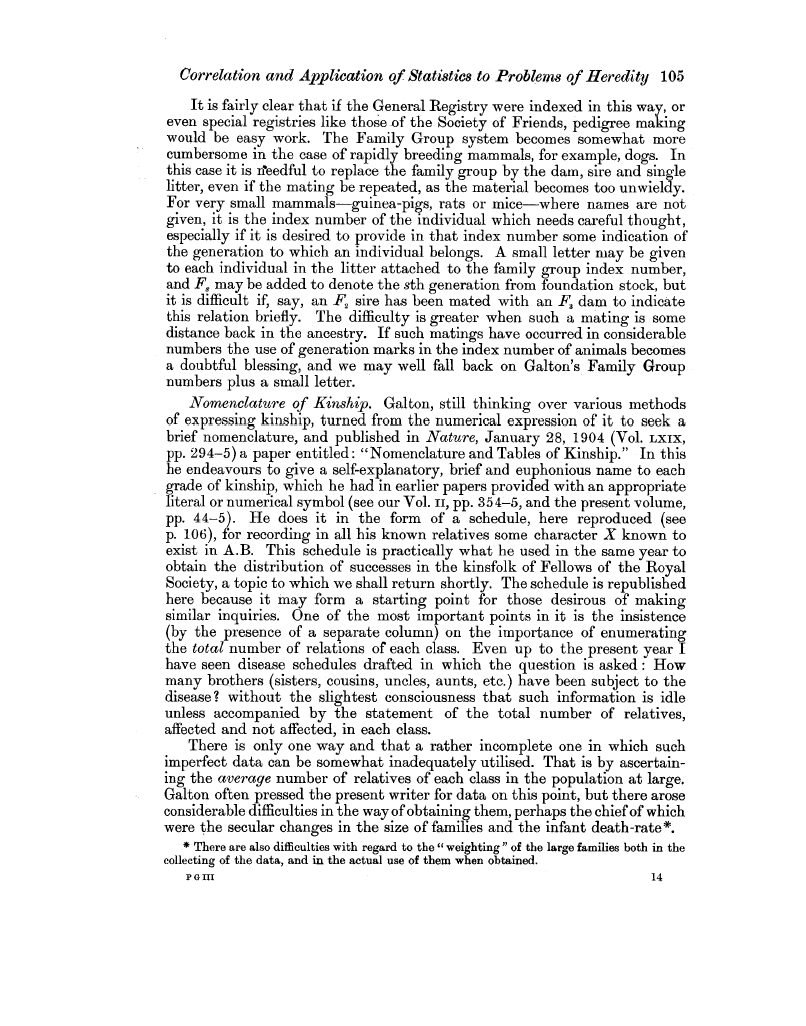| ||||||

OCR Rendition - approximate
Correlation and Application of Statistics, to Problems of Heredity 105 It is fairly clear that if the General Registry were indexed in this way, or even special registries like those of the Society of Friends, pedigree making would be easy work. The Family Group system becomes somewhat more cumbersome in the case of rapidly breeding mammals, for example, dogs. In this case it is needful to replace the family group by the dam, sire and single litter, even if the mating be repeated, as the material becomes too unwieldy. For very small mammals-guinea-pigs, rats or mice-where names are not given, it is the index number of the individual which needs careful thought, especially if it is desired to provide in that index number some indication of the generation to which an individual belongs. A small letter may be given to each individual in the litter attached to the family group index number, and F., may be added to denote the sth generation from foundation stock, but it is difficult if, say, an F, sire has been mated with an F, dam to indicate this relation briefly. The difficulty is greater when such a mating is some distance back in the ancestry. If such matings have occurred in considerable numbers the use of generation marks in the index number of animals becomes a doubtful blessing, and we may well fall back on Galton's Family Group numbers plus a small letter. Nomenclature of Kinship. Galton, still thinking over various methods of expressing kinship, turned from the numerical expression of it to seek a brief nomenclature, and published in Nature, January 28, 1904 (Vol. LXIX, pp. 294-5) a paper entitled : "Nomenclature and Tables of Kinship." In this he endeavours to give a self-explanatory, brief and euphonious name to each grade of kinship, which he had in earlier papers provided with an appropriate literal or numerical symbol (see our Vol. ii, pp. 354-5, and the present volume, pp. 44-5). He does it in the form of a schedule, here reproduced (see p. 106), for recording in all his known relatives some character X known to exist in A.B. This schedule is practically what he used in the same year to obtain the distribution of successes in the kinsfolk of Fellows of the Royal Society, a topic to which we shall return shortly. The schedule is republished here because it may form a starting point for those desirous of making similar inquiries. One of the most important points in it is the insistence (by the presence of a separate column) on the importance of enumerating the total number of relations of each class. Even up to the present year I have seen disease schedules drafted in which the question is asked : How many brothers (sisters, cousins, uncles, aunts, etc.) have been subject to the disease? without the slightest consciousness that such information is idle unless accompanied by the statement of the total number of relatives, affected and not affected, in each class. There is only one way and that a rather incomplete one in which such imperfect data can be somewhat inadequately utilised. That is by ascertaining the average number of relatives of each class in the population at large. Galton often pressed the present writer for data on this point, but there arose considerable difficulties in the way of obtaining them, perhaps the chief of which were the secular changes in the size of families and the infant death-rate *. * There are also difficulties with regard to the C0 weighting" of the large families both in the collecting of the data, and in the actual use of them when obtained. P G III 14
|